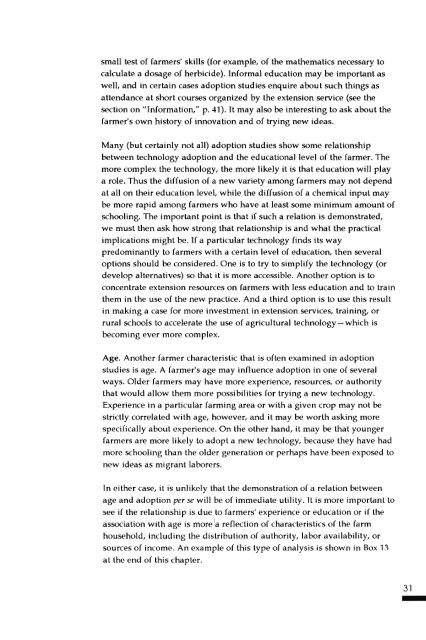The Adoption of Agricultural Technology - Food Security Group
The Adoption of Agricultural Technology - Food Security Group
The Adoption of Agricultural Technology - Food Security Group
You also want an ePaper? Increase the reach of your titles
YUMPU automatically turns print PDFs into web optimized ePapers that Google loves.
small test <strong>of</strong> farmers' skills (for example, <strong>of</strong> the mathematics necessary tocalculate a dosage <strong>of</strong> herbicide). Informal education may be important aswell, and in certain cases adoption studies enquire about such things asattendance at short courses organized by the extension service (see thesection on "Information," p. 41). It may also be interesting to ask about thefarmer's own history <strong>of</strong> innovation and <strong>of</strong> trying new ideas.Many (but certainly not all) adoption studies show some relationshipbetween technology adoption and the educational level <strong>of</strong> the farmer. <strong>The</strong>more complex the technology, the more likely it is that education will playa role. Thus the diffusion <strong>of</strong> a new variety among farmers may not dependat all on their education level, while the diffusion <strong>of</strong> a chemical input maybe more rapid among farmers who have at least some minimum amount <strong>of</strong>schooling. <strong>The</strong> important point is that if such a relation is demonstrated,we must then ask how strong that relationship is and what the practicalimplications might be. If a particular technology finds its waypredominantly to farmers with a certain level <strong>of</strong> education, then severaloptions should be considered. One is to try to simplify the technology (ordevelop alternatives) so that it is more accessible. Another option is toconcentrate extension resources on farmers with less education and to trainthem in the use <strong>of</strong> the new practice. And a third option is to use this resultin making a case for more investment in extension services, training, orrural schools to accelerate the use <strong>of</strong> agricultural technology-which isbecoming ever more complex.Age. Another farmer characteristic that is <strong>of</strong>ten examined in adoptionstudies is age. A farmer's age may influence adoption in one <strong>of</strong> severalways. Older farmers may have more experience, resources, or authoritythat would allow them more pOSSibilities for trying a new technology.Experience in a particular farming area or with a given crop may not bestrictly correlated with age, however, and it may be worth asking morespecifically about experience. On the other hand, it may be that youngerfarmers are more likely to adopt a new technology, because they have hadmore schooling than the older generation or perhaps have been exposed tonew ideas as migrant laborers.In either case, it is unlikely that the demonstration <strong>of</strong> a relation betweenage and adoption per se will be <strong>of</strong> immediate utility. It is more important tosee if the relationship is due to farmers' experience or education or if theassociation with age is more la reflection <strong>of</strong> characteristics <strong>of</strong> the farmhousehold, including the distribution <strong>of</strong> authority, labor availability, orsources <strong>of</strong> income. An example <strong>of</strong> this type <strong>of</strong> analysis is shown in Box Bat the end <strong>of</strong> this chapter.-31



